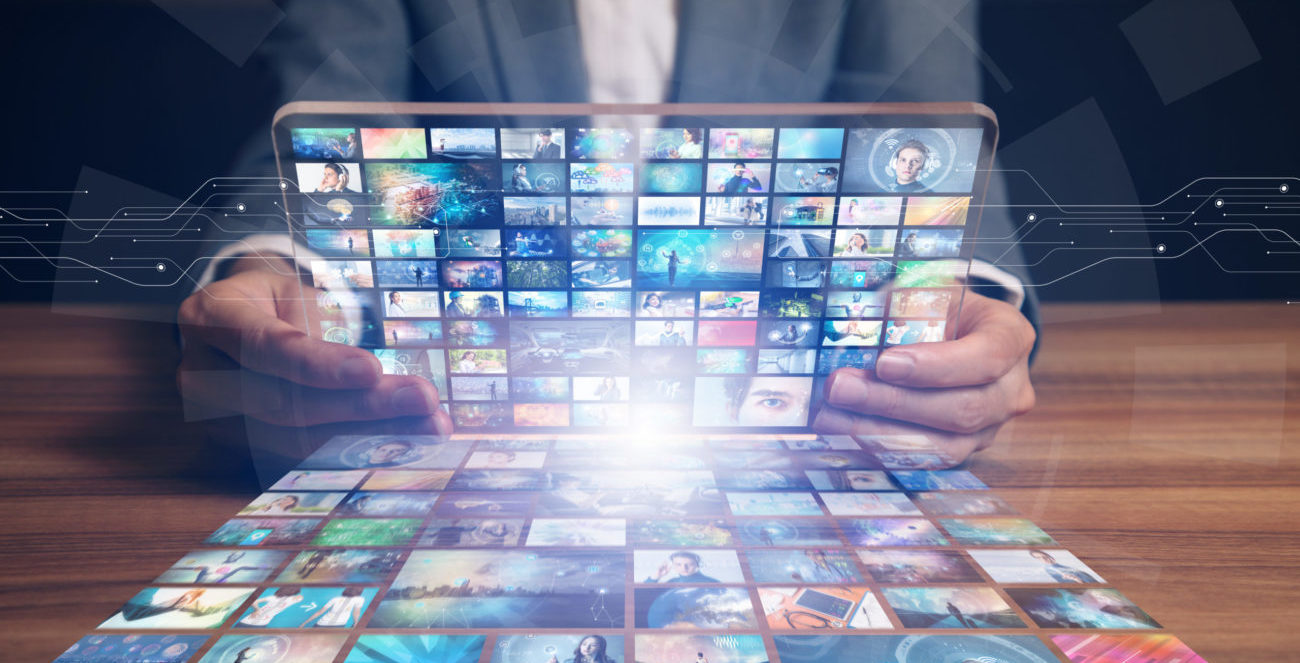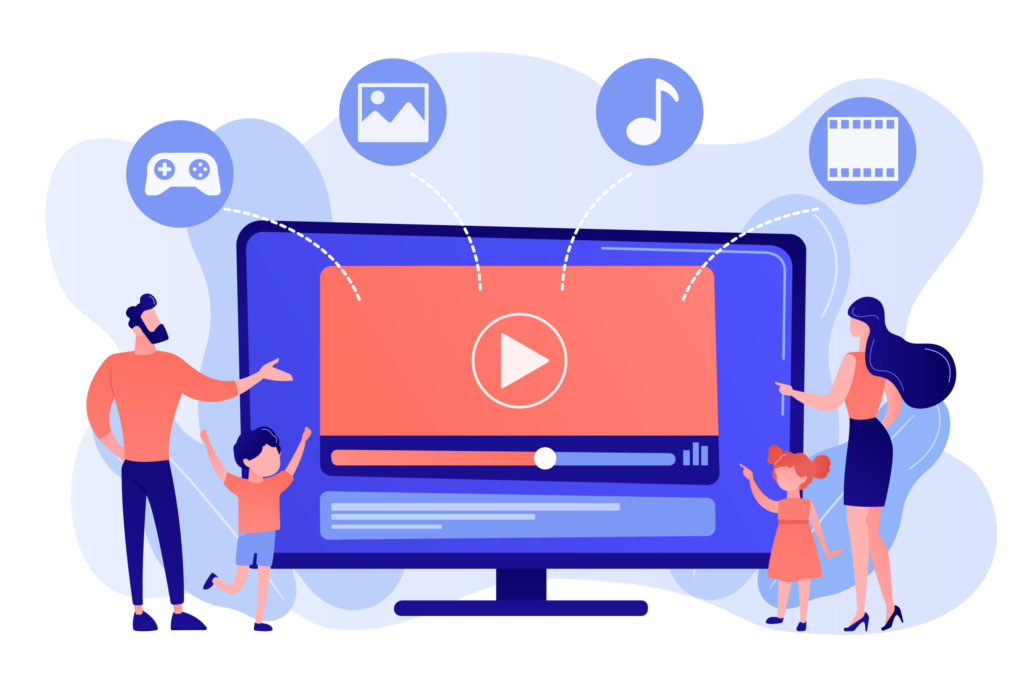M+E Connections

Streaming on the Global Internet Superhighway
Story Highlights
We’re not certain if cancelling your cable bundle is a battle of wits or stubborn perseverance, but either way, it isn’t fun. O.K., maybe a little fun.
Now you can sign up for a couple of SVOD services, a FAST service and throw in a couple of AVOD services when you want to watch something you never knew had even been made a few years ago so … it’s new (to you).
Picking what, where, when is kinda cool but now you must make a decision rather than hitting the remote and seeing what’s on.
But in some ways, we miss our old bundle.
Today, the kids close the door to their room and watch what they want on their own screens. If my wife or I grab the controller first, he or she gets the choice of what will appear on our big screen and the other one gets a choice: watch it and keep our mouth shut or retreat to our office and watch something else (yes, we usually lose).
Despite these “shortcomings,” the best thing is we’ve cut our monthly home entertainment bill from $100-$200 (depending on where you live) to $50 or less.
 Wait a minute.
Wait a minute.
The stuff has got to get from their server to your screen, which means you still have an ISP bill and that last 100 feet of connectivity costs $20-$50, depending on where you live and the bandwidth you choose.
Sir Tim Bernes-Lee, who is credited with developing the internet, has said web access is a “human right” and the UN agreed. Someone must build/maintain the infrastructure and those folks like to be paid for their investment/work.
So, we pay them.
Don’t grumble about it because you need that connection to the internet and everything it has to offer. You know, the service that ties the global population together. It’s the thing that enables folks to scream at and say vile things to each other no matter where we live without really being seen and enjoying the content we choose.
We should note that we avoid those “discussions” and focus on intelligent, productive, entertaining stuff. We’re just glad we have that connection because it allows us to work from home when we want, stay in touch with folks and stream entertainment to our TV or other screen.
Living and working in the heart of Silicon Valley, we take our anytime, anywhere, as much as we need internet service/speed for granted but connectivity isn’t a level playing field.
The world currently has a population of about 8 billion people with an annual growth rate of 1 percent per year and well over half (57 percent) living in urban areas. Of the nearly 5.2 billion internet users worldwide (64-plus percent of the global population) 60 percent of those with global connectivity are social media users.
More than 95-plus percent (6.8 billion) use aa inexpensive mobile phone for very basic communications. However increasingly, and especially in developing countries, more expensive, more versatile smartphones are an individuals’ primary source of communications and entertainment.
In the Americas, more than 82 percent of the population has a smartphone followed by the UK (79 plus percent) and France/Germany slightly less than 79 percent. Smartphone usage drops significantly in emerging countries where a lack of basic infrastructure and high rates of poverty put the price of the devices out of reach for many.
For example, only 55.4 percent of Brazil’s population have a smartphone and it drops to 35.4 percent in India.
In many areas of Africa more than half of the population is below 20 years of age. In Nigeria, fewer than one in five people (19.7 percent) use smartphones while in the Central African Republic, internet adoption is extremely sparse. Fewer than 1 in 7 have electricity let alone the “luxury” of the internet. Heck, most people don’t even have basic sanitation, so internet connectivity and certainly video entertainment is a very low priority.
Think about that before you complain about not having true 4K to your screen or your device buffers because of slow internet connectivity and you can’t fully enjoy your streaming video or music.
Broadband connectivity (25 Mbps download or greater) is the minimum connectivity service people need to kick back and enjoy all the shows/movies they want to watch, according to Allan McLennan, founder and global managing director of PADEM Media Group.
He notes that the younger generation that was almost born with a mobile phone in their hands and people in emerging countries need the capacity and performance of wireless 5G.
 “The internet, and more importantly, broadband — wired and wireless — is the lifeline for home and the personal entertainment industry,” he said. “Without really robust wired, wireless broadband service, there’s not really an incentive for people to buy 4K TVs, smartphones or streaming video services.”
“The internet, and more importantly, broadband — wired and wireless — is the lifeline for home and the personal entertainment industry,” he said. “Without really robust wired, wireless broadband service, there’s not really an incentive for people to buy 4K TVs, smartphones or streaming video services.”
Despite the momentary slowdown of the pandemic, the global broadband internet market will reach more than $404 billion this year, a CAGR (compound annual growth rate) of 3.9 percent.
Europe and North America have the greatest penetration of broadband (copper and fiber) even though only 50 percent of US households (primarily rural) have the necessary download speeds. Fifteen percent of U.S. households don’t have internet access and 10 percent rely solely on smartphone communications.
While fiber broadband is continuing to show steady growth in the EU, North America and a dramatic upsurge in APAC countries; so, has the service cost.
“Wireless and wired broadband performance and cost varies widely from country to country as well as from rural to urban locations,” McLennan said. “In Nigeria, for example, a person has to work 33 hours to pay for the least expensive broadband service while in Canada they work seven minutes to pay for the same level of service.”
As a result, he recommends people periodically check their broadband performance and cost and compare the results with other options in their area.
And if you want to feel good – or bad, compare that with the latest global service monitoring services such as SpeedTest.net and Numbeo.
Fast, reliable, and economic internet service is important for business and the global economy; but for our kids and 66.2 percent of the world’s population, it is absolutely vital.
Usage has grown a whopping 1,355 percent in the past three years with more than 2.7 billion of the Asians camping out on the internet while 93.4 percent of Americans and 88.4 percent of Europeans use it regularly.
Fifty-four-point four percent of the traffic comes from mobile phone devices and nearly everyone (but us) visits their social media sites — including photo/video — several times a day.
But it’s video streaming that consumes most of the bandwidth capacity — 65 percent of all internet traffic is video — with more than 200 global, regional, and national services expected to reach 1.7 billion subscribers this year. To ease the impact of constantly rising subscription fees, nearly all of them offer advertising tier options.
My wife and kids (and probably your family as well) don’t care about how much traffic is on the internet. They just want their show/movie entertainment without having to think about it.
But for 4K content, your connection must speed along the internet from their server to your device at 15-18 Mbps with all the quality possible, even as UHD 4K requires a download speed of 25 Mbps.
Rather than dodge the issue or make subscribers “settle” for lower-quality content (SD or HD), Netflix solved the high-quality streaming/bandwidth issue by developing some open-source advanced encoding technology which has been used and further enhanced by others in the industry.
If you’re interested in that kind of stuff, find out more here https://tinyurl.com/3cvxm6uy , or do what we do: check out one of your new favorite projects.
In addition, Netflix strategically located 5,000ish video servers around the globe and constantly analyze its traffic to determine where more needs to be added to almost instantly put the show/movie you want on your screen.
 That’s important because Netflix streaming is available in more than 190 countries around the globe. Amazon Prime Video is available in 200 countries and territories while YouTube is available in over 100 countries.
That’s important because Netflix streaming is available in more than 190 countries around the globe. Amazon Prime Video is available in 200 countries and territories while YouTube is available in over 100 countries.
We know you don’t care, but all that internet infrastructure, tech analysis and investment are what delivers entertainment to your home or the screen in your hand.
For those who don’t have, can’t afford, or simply don’t want high-speed broadband wired or wireless service, there’s always rent a DVD from Netflix red envelope service (being phased out), Redbox at your grocery store or Blockbuster (if you live in Bend, Ore.).
Or, if you choose either of the two options, just wave at Beau Grimmer when you see him and his crew out there day or night, rain, or shine.
As he said, he has an important job, “Our main mission is to protect the grid, even if one of us meets our maker. We are linemen, it is what we do, the credo we chant, you are your brother’s keeper.”
They’re the folks the rest of us count on when we turn on our big 4K screen or grab our phone to instantly get the show or movie on the screen of our choice.
Theirs is the unglamorous part of the anywhere, anytime, any show/movie entertainment service industry that is usually overlooked but really appreciated.
Andy Marken [email protected] is an author of more than 800 articles on management, marketing, communications, industry trends in media and entertainment, consumer electronics, software and applications.









